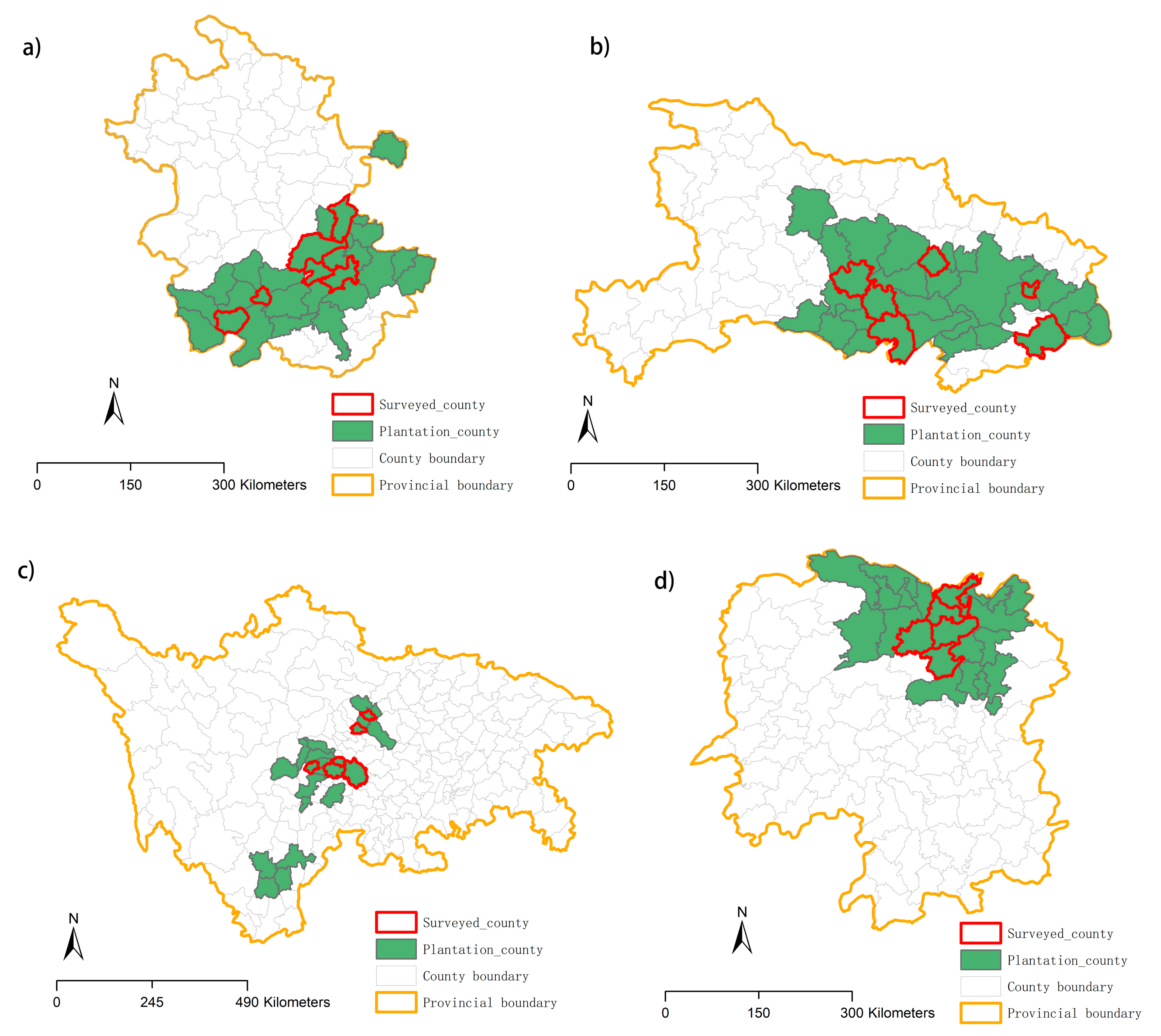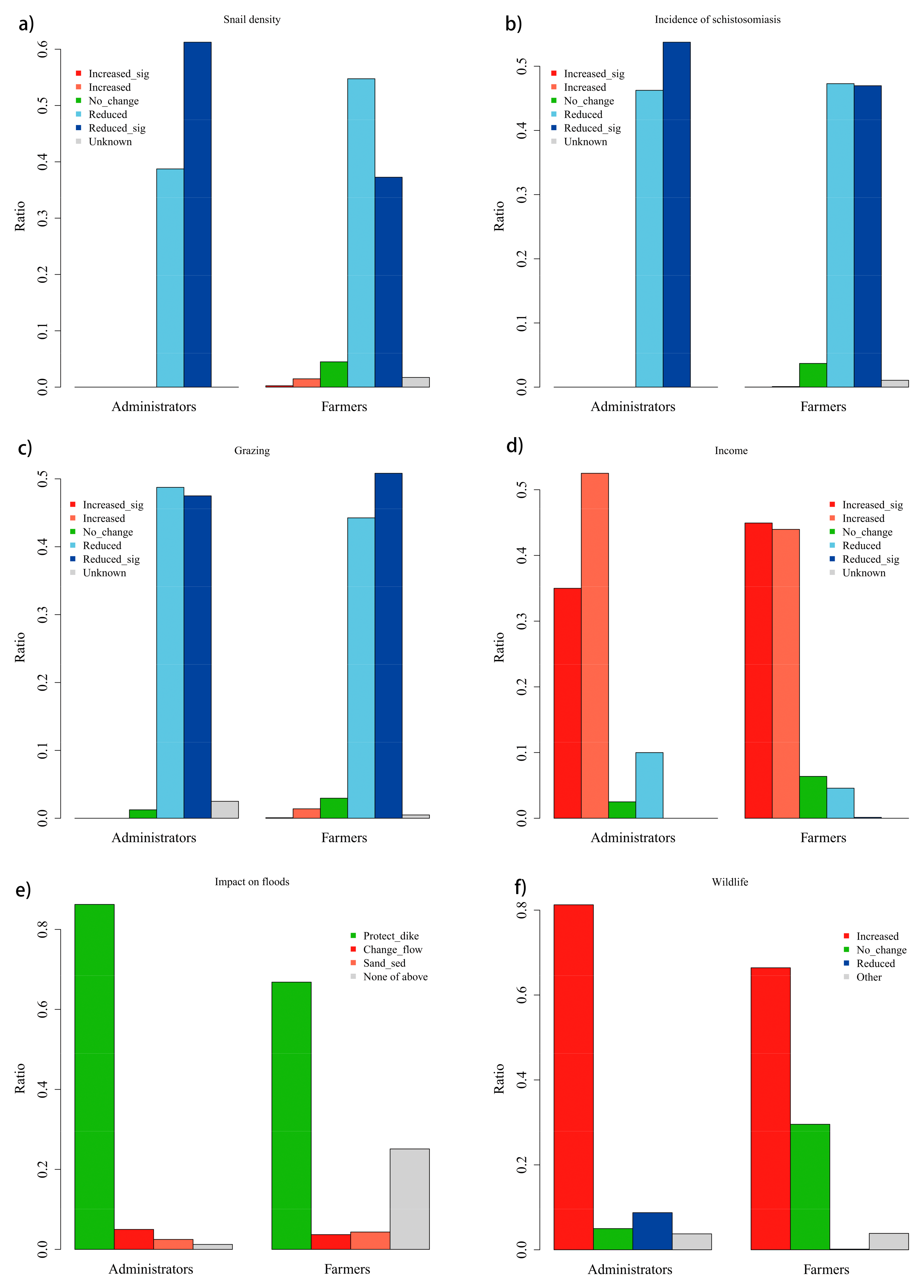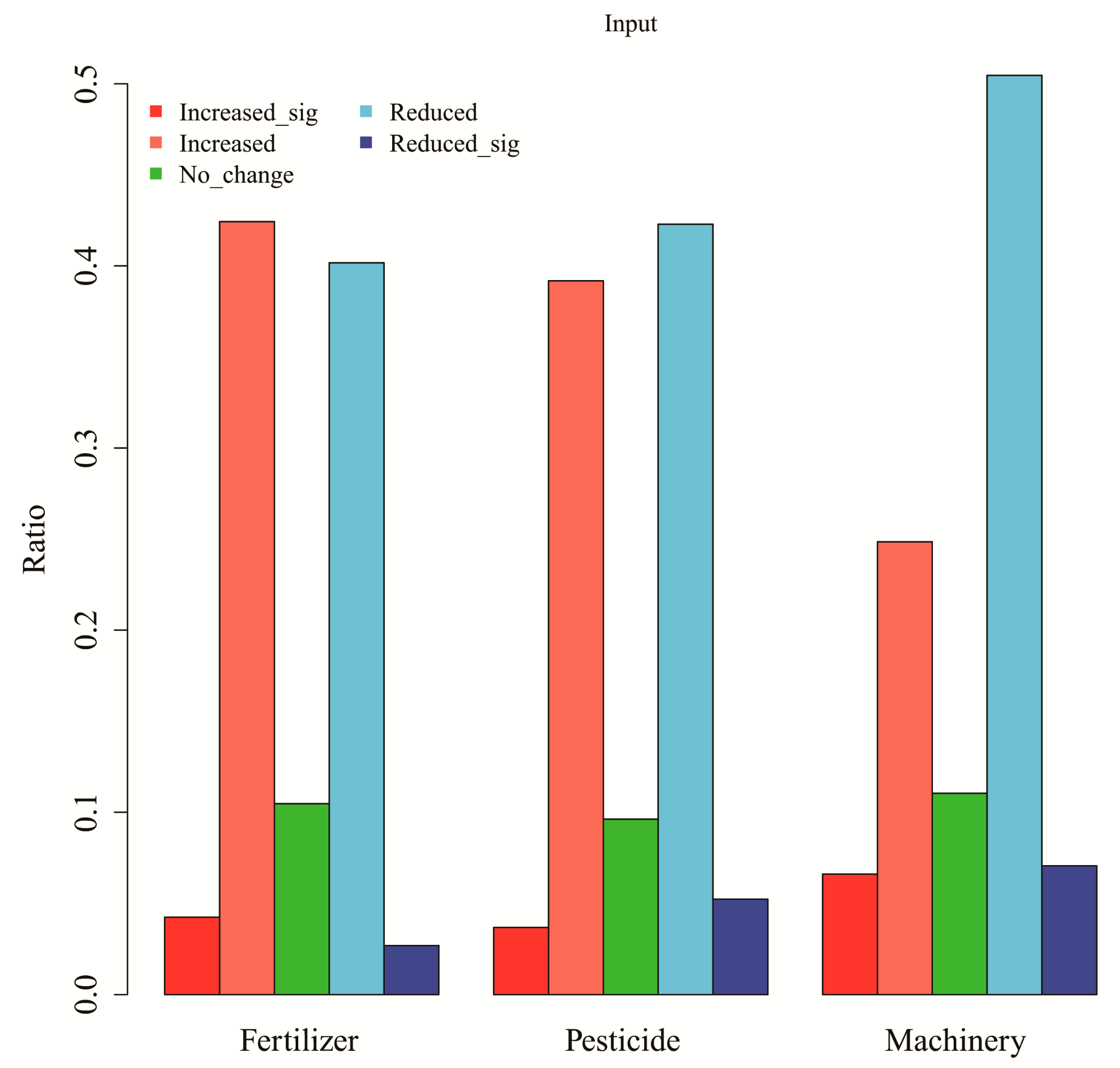The Stakeholders’ Views on Planting Trees to Control Schistosomiasis in China
Abstract
1. Introduction
2. Materials and Methods
2.1. Study Area
2.2. Design of Survey Questions
2.3. Data Collection and Analysis
3. Results
3.1. The Planted Areas and the Overall Trend of Snail Habitats
3.2. Characteristics of Respondents
3.3. Knowledge of Schistosomiasis
3.4. Effectiveness of the Planting Program
3.5. Factors Affecting Participation in the Planting Program
4. Discussion
5. Conclusions
Supplementary Materials
Author Contributions
Funding
Acknowledgments
Conflicts of Interest
References
- World Health Organization. Schistosomiasis. Available online: https://www.who.int/en/news-room/fact-sheets/detail/schistosomiasis (accessed on 1 November 2019).
- World Health Organization. Neglected Tropical Diseases: Prevention, Control, Elimination and Eradication; World Health Organization: Geneva, Switzerland, 2013. [Google Scholar]
- United Nations. Transforming Our World: The 2030 Agenda for Sustainable Development; United Nations: New York, NY, USA, 2015. [Google Scholar]
- Sokolow, S.H.; Wood, C.L.; Jones, I.J.; Lafferty, K.D.; Kuris, A.M.; Hsieh, M.H.; De Leo, G.A. To reduce the global burden of human schistosomiasis, use ‘Old fashioned’ snail control. Trends Parasitol. 2018, 34, 23–40. [Google Scholar] [CrossRef]
- Evan Secor, W. Water-based interventions for schistosomiasis control. Pathog. Global Health 2014, 108, 246–254. [Google Scholar] [CrossRef] [PubMed]
- Yang, G.J.; Sun, L.P.; Hong, Q.B.; Zhu, H.R.; Yang, K.; Gao, Q.; Zhou, X.N. Optimizing molluscicide treatment strategies in different control stages of schistosomiasis in the People’s Republic of China. Parasites Vectors 2012, 5. [Google Scholar] [CrossRef] [PubMed]
- Coelho, P.M.Z.; Caldeira, R.L. Critical analysis of molluscicide application in schistosomiasis control programs in Brazil. Infect. Dis. Poverty 2016, 5. [Google Scholar] [CrossRef] [PubMed]
- Negm, A.Y.; Ibrahim, I.R.; El-Temsahy, M.M.; El-Azzouni, M.Z. Effect of topical agents on cercariae of Schistosoma mansoni. J. Egypt. Soc. Parasitol. 2004, 34, 903–913. [Google Scholar] [PubMed]
- Lowe, D.; Xi, J.; Meng, X.; Wu, Z.; Qiu, D.; Spear, R. Transport of Schistosoma japonicum cercariae and the feasibility of niclosamide for cercariae control. Parasitol. Int. 2005, 54, 83–89. [Google Scholar] [CrossRef]
- Yi, Y.; Xu, X.J.; Dong, H.F.; Jiang, M.S.; Zhu, H.G. Transmission control of schistosomiasis japonica: Implementation and evaluation of different snail control interventions. Acta Tropica 2005, 96, 191–197. [Google Scholar] [CrossRef]
- Nihei, N.; Kanazawa, T.; Blas, B.L.; Saitoh, Y.; Itagaki, H.; Pangilinan, R.; Matsuda, H.; Yasuraoka, K. Soil factors influencing the distribution of Oncomelania quadrasi, the intermediate host of Schistosoma japonicum, on Bohol Island, Philippines. Ann. Trop. Med. Parasitol. 1998, 92, 699–710. [Google Scholar] [CrossRef]
- Li, L.Y.; Lu, J.Y.; Fan, B.L.; Wang, J.S.; Zheng, S. Delayed response of snails’ vertical distribution on the bottomland to the changing water level at the downstream area of the Three Gorges project. Ecol. Inform. 2015, 30, 185–193. [Google Scholar] [CrossRef]
- Komiya, Y. Cementing ditches of the habitat of Oncomelania nosophora, the intermediate host of schistosoma japonicum, as a preventive measure of schistosomiasis—A review. Jpn. J. Med. Sci. Biol. 1965, 18, 275–281. [Google Scholar] [CrossRef]
- Dong, Y.; Feng, X.G.; Huang, P.; Dong, X.Q.; Shi, X.W.; Yang, W.C. Effect of water—Saving irrigation engineering on schistosomiasis control in Eryuan County of Yunnan Province. Chin. J. Schistosomiasis Control. 2013, 25, 393–395. [Google Scholar]
- Yang, X.; Zhang, Y.; Sun, Q.X.; Zhou, J.X.; Zhou, X.N. SWOT analysis on snail control measures applied in the national schistosomiasis control programme in the People’s Republic of China. Infect. Dis. Poverty 2019, 8. [Google Scholar] [CrossRef] [PubMed]
- Hong, X.C.; Xu, X.J.; Chen, X.; Li, Y.S.; Yu, C.H.; Yuan, Y.; Chen, Y.Y.; Li, R.D.; Qiu, J.; Liu, Z.C.; et al. Assessing the effect of an integrated control strategy for schistosomiasis japonica emphasizing bovines in a marshland area of Hubei Province, China: A cluster randomized trial. PLoS Negl. Trop. Dis. 2013, 7, e2122. [Google Scholar] [CrossRef] [PubMed]
- Wang, X.; Wang, W.; Wang, P. Long-term effectiveness of the integrated schistosomiasis control strategy with emphasis on infectious source control in China: A 10-year evaluation from 2005 to 2014. Parasitol. Res. 2017, 116, 521–528. [Google Scholar] [CrossRef] [PubMed]
- Zhang, S.M.; Buddenborg, S.K.; Adema, C.M.; Sullivan, J.T.; Loker, E.S. Altered gene expression in the schistosome-transmitting snail Biomphalaria glabrata following exposure to niclosamide, the active ingredient in the widely used molluscicide bayluscide. PLoS Negl. Trop. Dis. 2015, 9. [Google Scholar] [CrossRef]
- Perrett, S.; Whitfield, P.J. Currently available molluscicides. Parasitol. Today 1996, 12, 156–159. [Google Scholar] [CrossRef]
- Yu, Q.; Wen, L.Y.; Huang, S.Y.; Zhang, J.F.; Li, L.S.; Zhong, B.; Liang, Y.S.; Guo, J.G. Evaluation on investment of schistosomiasis surveillance effectiveness in schistosomiasis transmission interrupted areas from 2006 to 2010. Int. J. Med. Parasites Dis. 2012, 39, 13–19. [Google Scholar]
- Zhang, L. Thoughts and suggestions on implementing ban of grazing on sandbanks in schistosomiasis epidemic zones in Anxiang, Hunan Province. Hunan Anim. Sci. Veterinary Med. 2018, 33–34. [Google Scholar]
- Tang, Y.X.; Wu, M.; Wu, L.X.; Tang, J.; Lin, J.X. Effects of lakeside plantations on schistosomiasis control. Wetl. Sci. Manag. 2006, 2, 8–13. [Google Scholar]
- Xia, S.G.; Liu, H.X.; He, J.B.; Zhou, Y.Y.; Li, P.X. Characterization of the distribution of Oncomelania hupensis in Schistosoma prevention forests at different ages. Wetl. Sci. Manag. 2012, 8, 4–6. [Google Scholar]
- Hu, X. Forestry Schistosomiasis implementation and prospects in Hubei. Hubei For. Sci. Technol. 2016, 45, 1–5. [Google Scholar]
- Xiao, Y.; Sun, Q.X.; Zhu, Z.; Wei, G.; Zhou, J.X. Discussion on strategy of development of forestry schistosomiasis control programs of China in new period. Chin. J. Schistosomiasis Control. 2018, 30, 472–475. [Google Scholar] [CrossRef]
- Liu, G.; Li, K.; Zhang, C. Snail control effect and eco-economical benefit of forest for snail control and schistosomiasis prevention in mountainous regions. Chin. J. Schistosomiasis Control. 2011, 23, 386–389. [Google Scholar] [CrossRef]
- Li, C.; Teng, J.X.; Zhou, Z.X.; Hu, X.Y.; Sun, Q.X. Configuration model of snail control and schistosomiasis prevention forest based on comprehensive benefit evaluation in Shishou city. For. Inven. Plan. 2018, 43, 69–77. [Google Scholar]
- Jing, L.; Lyu, C.; Zhou, Y.; Zuo, A.J.; Lei, G.C. Spatio-temporal characteristics of the expansion of poplar plantation in West Dongting Lake wetland, China. Chin. J. Appl. Ecol. 2016, 27, 2039–2047. [Google Scholar] [CrossRef]
- Zhou, L.Y.; Deng, Y.; Steinmann, P.; Yang, K. The effects of health education on schistosomiasis japonica prevalence and relevant knowledge in the People’s Republic of China: A systematic review and meta-analysis. Parasitol. Int. 2013, 62, 150–156. [Google Scholar] [CrossRef]
- King, C.H. Parasites and poverty: The case of schistosomiasis. Acta Tropica 2010, 113, 95–104. [Google Scholar] [CrossRef]
- Wu, M.; Wu, L.X.; Tang, Y.X.; Xu, S.; Lin, J.X. Effect of reed and poplar plantation on the flow rate and sedimentation thickness in the flood period on the beach. Hunan For. Sci. Technol. 2014, 41, 13–17. [Google Scholar]
- Sun, Y.; Wang, L.; Huang, C. Plant diversity under poplar plantations in Yangtze River beach in Anhui. Wetl. Sci. Manag. 2012, 8, 4–7. [Google Scholar]
- Fan, J.; Qiu, D.; Wang, W.; Lei, T. Bird community structure and protection measures under various habitats in west Dongtinghu Lake. Wetl. Sci. 2015, 13, 258–264. [Google Scholar]
- He, X.; Yang, C.; Liu, G. Diversity of insects in plantation for snail control and schistosomiasis prevention on the Middle and the Lower Reaches of Yangtze River. Wetl. Sci. Manag. 2012, 8, 4–7. [Google Scholar]
- Liu, T.; Liu, C.; Liu, H.; Wang, S.; Rong, Q.; Zhu, W. Did the key priority forestry programs affect income inequality in rural China? Land Use Policy 2014, 38, 264–275. [Google Scholar] [CrossRef]



| Variables | Description |
|---|---|
| Impact of plantations on snail densities | A = “Increased significantly”, B = “Increased”, C = “No change”, D = “Reduced”, E = “Reduced significantly”, F = “Unknown” |
| Impacts on incidences of schistosomiasis | A = “Increased significantly”, B = “Increased”, C = “No change”, D = “Reduced”, E = “Reduced significantly”, F = “Unknown” |
| Impacts on grazing | A = “Increased significantly”, B = “Increased”, C = “No change”, D = “Reduced”, E = “Reduced significantly”, F = “Unknown” |
| Impacts on floods | A = “Protect banks and dikes”, B = “Change the flow paths of floods”, C = “Create sand sedimentation”, D = “None of them” |
| Impacts on wildlife | A = “Increased”, B = “No change”, C = “Reduced”, D = “Other” |
| Impact on farmer’s income | A = “Increased significantly”, B = “Increased”, C = “No change”, D = “Reduced”, E = “Reduced significantly”, F = “Unknown” |
| Variables | Description |
|---|---|
| Socioeconomic characteristics | |
| Number of labors | Number of family members ≥ 18 years old |
| Family income | Annual household income, with 1 = ”<RMB10K”, 2 = ”RMB10K-29K”, 3 = ”RMB30K-49k”, 4 = ”RMB50K-69k”, 5 = ”≥RMB-70K” |
| Knowledge and participation | |
| Knowledge of schistosomiasis | Respondents’ knowledge of schistosomiasis, with 5 = correctly selected all five effective measures; 0 = no effective measures have been correctly selected |
| Participation in control activities | The number of control measures that respondents have participated in other than tree planting |
| Most effective measures to control grazing | Respondents’ choice of the most effective measure to control grazing, with 1 = if plantation selected, 0 = plantation not selected |
| Use of lands | |
| Types of use | The number of activities practiced at lands other than tree planting |
| Province | Name of the County/District | Area of Tree Plantation (ha) | Change in the Area of Snail Habitat (%) |
|---|---|---|---|
| Anhui | Daguan District | 666.7 | +86.4 |
| Tongling County | 1160.0 | −12.9 | |
| Nanling County | 3626.7 | −18.7 | |
| Hexian County | 3953.3 | +0.04 | |
| Wangjiang County | 4880.0 | −19.4 | |
| Wuwei County | 6376.0 | −71.1 | |
| Hubei | Yingcheng County | 2513.3 | −14.5 |
| Qianjiang County | 2715.0 | −23.6 | |
| Shayang County | 3390.0 | −97.0 | |
| Yangxin County | 3736.7 | −28.7 | |
| Huangzhou District | 4053.3 | −30.0 | |
| Jianli County | 11,393.3 | −7.8 | |
| Hunan | Datonghu District | 1222.1 | −4.9 |
| Heshan District | 1366.7 | −21.3 | |
| Nanxian County | 6666.7 | +3.4 | |
| Huarong County | 10,000.0 | −20.0 | |
| Hanshou County | 23,000.0 | −0.4 | |
| Yuanjiang County | 41,200.0 | −0.3 | |
| Sichuan | Guanghan City | 276.7 | +231.8 |
| Mingshan District | 680.3 | −100.0 | |
| Luojiang County | 1060.0 | +401.1 | |
| Pengshan District | 1666.0 | +1438.1 | |
| Dongpo District | 1963.3 | +811.2 | |
| Renshou County | 5728.7 | −71.1 |
| Characteristics | Number | Percentage (%) |
|---|---|---|
| Gender | ||
| Female | 112 | 9.2 |
| Male | 1106 | 90.8 |
| Age Class | ||
| <20 | 2 | 0.16 |
| 20–39 | 143 | 11.74 |
| 40–59 | 818 | 67.16 |
| ≥60 | 255 | 20.94 |
| Education Level | ||
| Illiterate | 24 | 1.97 |
| Primary School | 234 | 19.21 |
| Middle School | 609 | 50.0 |
| High School | 276 | 22.66 |
| College and Above | 75 | 6.16 |
| Annual Family Income Level | ||
| <10K | 38 | 3.12 |
| 10K–29K | 191 | 15.68 |
| 30K–49K | 331 | 27.18 |
| 50K–69K | 302 | 24.8 |
| ≥70K | 356 | 29.22 |
| Main Benefit | Frequency | Main Problem | Frequency |
|---|---|---|---|
| Improve the environment | 379 | Reduce income or slow return | 25 |
| Increase income | 320 | Affect the yield of crops | 20 |
| Reduce disease | 319 | Difficult for grazing | 20 |
| Reduce snails | 131 | Loss of farmland | 11 |
| Improve air quality | 109 | Need investment | 7 |
| Lower labor intensity | 29 | Reduce fishing activities | 7 |
| Soil and water conservation | 28 | Denial of access to places | 6 |
| Good for general health | 17 | Increase forest fire risk | 5 |
| Prevent flood | 15 | Affect farming activities | 4 |
| More tree shade | 5 | Increase tree pests | 3 |
| Estimate | SE | z Value | Pr(>|z|) | |
|---|---|---|---|---|
| Intercept | –0.618 | 0.629 | –0.982 | 0.326 |
| Number of labors | –0.067 | 0.067 | –0.996 | 0.319 |
| Family income22 | 0.806 | 0.436 | 1.893 | 0.058 |
| Family income 23 | 1.206 | 0.419 | 2.876 | 0.004 |
| Family income 24 | 0.871 | 0.425 | 2.050 | 0.040 |
| Family income 25 | 1.583 | 0.432 | 3.662 | 0.000 |
| Knowledge on schistosomiasis | 0.067 | 0.081 | 0.820 | 0.412 |
| Participate in other controlling programs | 0.048 | 0.072 | 0.654 | 0.513 |
| Plantation as the most effective way to control grazing | 0.515 | 0.157 | 3.273 | 0.001 |
| Other use of lands | –0.155 | 0.094 | –1.640 | 0.101 |
© 2020 by the authors. Licensee MDPI, Basel, Switzerland. This article is an open access article distributed under the terms and conditions of the Creative Commons Attribution (CC BY) license (http://creativecommons.org/licenses/by/4.0/).
Share and Cite
Yang, J.; Zhou, J.; Jin, J.; Sun, Q. The Stakeholders’ Views on Planting Trees to Control Schistosomiasis in China. Int. J. Environ. Res. Public Health 2020, 17, 939. https://doi.org/10.3390/ijerph17030939
Yang J, Zhou J, Jin J, Sun Q. The Stakeholders’ Views on Planting Trees to Control Schistosomiasis in China. International Journal of Environmental Research and Public Health. 2020; 17(3):939. https://doi.org/10.3390/ijerph17030939
Chicago/Turabian StyleYang, Jun, Jinxing Zhou, Jing Jin, and Qixiang Sun. 2020. "The Stakeholders’ Views on Planting Trees to Control Schistosomiasis in China" International Journal of Environmental Research and Public Health 17, no. 3: 939. https://doi.org/10.3390/ijerph17030939
APA StyleYang, J., Zhou, J., Jin, J., & Sun, Q. (2020). The Stakeholders’ Views on Planting Trees to Control Schistosomiasis in China. International Journal of Environmental Research and Public Health, 17(3), 939. https://doi.org/10.3390/ijerph17030939





